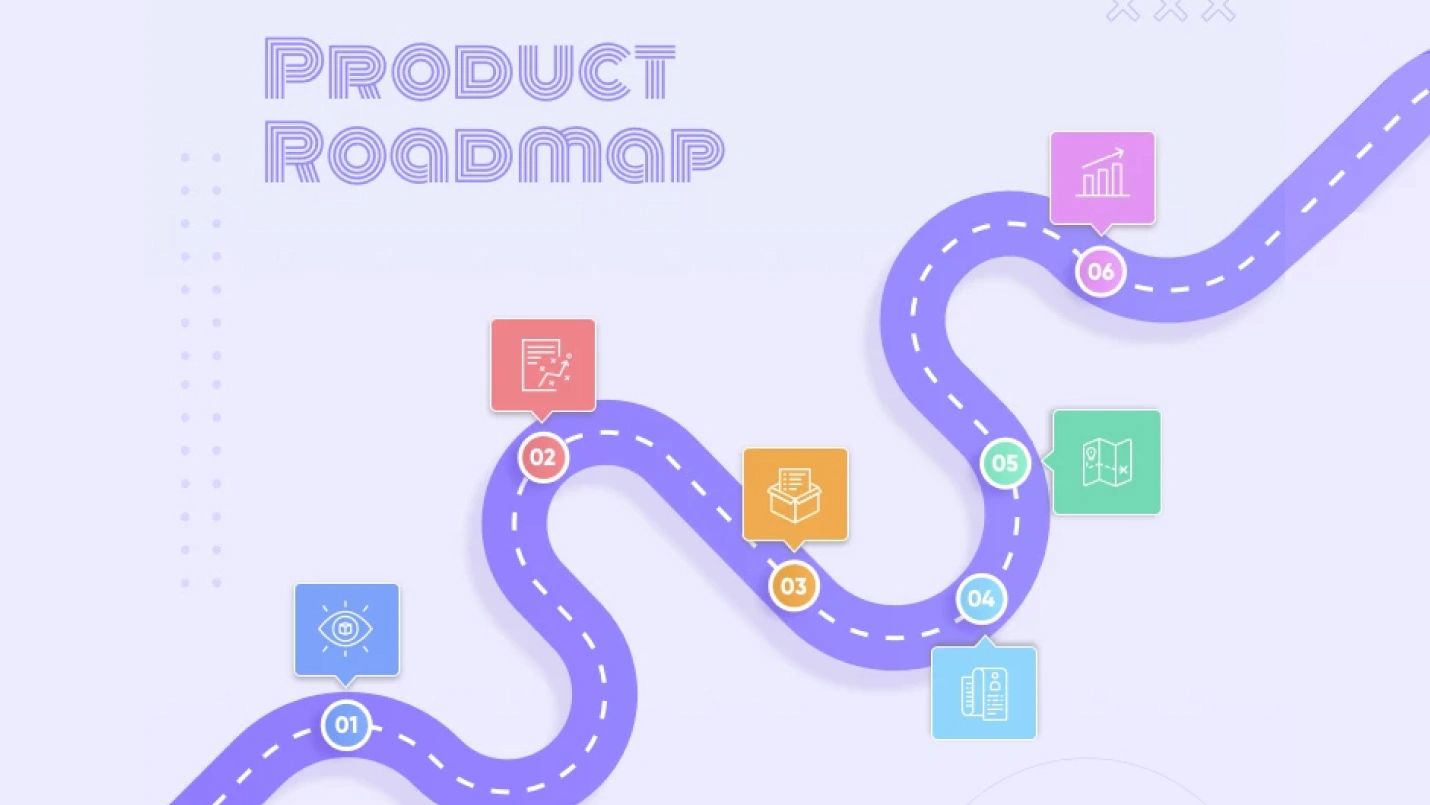Summary: “The process of creating a roadmap is not about random outbursts of energy. It requires elaborative planning. Here, you carefully weigh your every move and analyze how each step contributes to your product vision. You also prioritize everything to make sure only useful features make it into the product, bells & whistles are parked for later. By following the steps we mention in this blog, you can ensure that your product roadmap turns out precisely the way you want so that stakeholders are more likely to buy into it.”
Every established product development business knows that a brilliant idea alone is not enough for building a great product. You also must create a product roadmap, highlighting what needs to be done and when it is equally important. A brilliant strategy, aka a product roadmap, that highlights what needs to be done and when is equally important. It will ensure your product launches on time, and turns out to be what you had expected.
What is a Product Roadmap?
A product roadmap is a high-level visual summary that maps out your product vision and how you are planning to achieve it. It communicates what product you’re building, why you’re building it, and what steps you must take to bring your idea to reality.
Here are a couple of purposes that a product roadmap solves:
- Describe your product’s vision and strategy to product teams.
- Prepare a guideline for executing your product’s strategy
- Get all stakeholders on the same page
- Discuss and plan all the scenarios early on
Why do you Need a Product Roadmap?
The most significant reason behind creating a product roadmap is that it helps all the stakeholders become aware of the strategic vision of your product. Here are a few other reasons:
- A product roadmap helps you visually communicate the direction of your product and channel your team’s efforts in the right direction
- A product roadmap helps your team understand the bigger picture and ensures every team member focuses on tasks that matter. As a result, avoiding scope creep in your project and making fast decisions becomes easy
- A product roadmap helps you keep your leadership team aware of your progress in an easily understandable way
Therefore, a product roadmap avoids chaos from reigning, efforts from getting wasted on mundane tasks, and ensures your product launches in the market on time.

We respect your privacy. Your information is safe.
How to Create a Product Roadmap?
Creating a product roadmap requires elaborative planning. You must carefully think about how each aspect sums up the bigger picture and leads to the ultimate goal. Here are six basic steps that can help you get started:
Step 1: Understand the Product Vision
You can never reach a destination when you don’t know where you are going. Therefore, it’s essential to understand the vision of your product first.
For this, you must ask yourself the following questions:
- Why are you building the product, and why now?
- Who will use it?
- What pain points are you trying to solve?
- How does the market look?
- What strategic goals will you solve with your product?
- What is your unique value proposition?
These questions will help you understand what you want to achieve with your product and prepare a suitable strategy. As a result, you will not make uncluttered decisions. Instead, your every move will be calculated and lead towards your goals.
It would be best to have enough data to back the answers to these questions. It will help you justify your resources on the product and give confidence in your stakeholder meeting.
Step 2: Define the Product Strategy
Once you have clearly understood the product vision, the next step is to map out a strategy around it. A product strategy is how you present your product idea to stakeholders and convince them to invest in its development. It is crucial, as no one would invest their time and resources on something that yields no results.
An ideal product strategy answers all the questions we previously asked, It also creates a solid base to build the rest of the product and gives stakeholders a valid reason to support your idea.
Here are a few things you must keep in mind while defining the strategy of your product:
1. Choosing the Right Type of Product Roadmap
| Portfolio Roadmap | A portfolio roadmap shows planned releases across multiple products in a single view. | You visualize the entire workflow on a Kanban board to continuously process each work item. The end goal is to present a strategic overview of your product plan to executives and advisory boards.
For helping internal teams understand how their projects are related to the work of other departments. |
| Strategy Roadmap | A strategy roadmap communicates the high-level efforts a team needs to invest in to achieve your product goals. | To showcase your initiatives to executives.
To help internal teams understand how different releases will contribute to the business strategy. |
| Release Roadmap | A release roadmap communicates all the activities your team must conduct before a release. | For coordinating release activities with marketing, customer support, and sales team. |
| Features Roadmap | A features roadmap displays a timeline for when your team will deliver new features. | For communicating the details of upcoming updates with customers and other teams in the organization. |
2. Deciding What Goes Into Your Product Roadmap
A certain level of scrutiny is essential when creating a product roadmap. It will ensure only the vital elements make it into your product. Here’s what a product roadmap should ideally include:
- The end goal/vision of your product. It will set you on a path to create the product strategy
- A brief overview of what needs to be done. It will help clarify priorities, assign responsibilities, and allocate time to each task
- A timeline mentioning how much time you will spend at each phase along with the reasons that can cause possible delays
- A brief detail of what assistance you need from various teams and the management
- Markers to track progress during product development
- Metrics by which you will measure the success of your product
Here are a few things that you should keep in mind when deciding on what to include in a product roadmap:
- Make sure your product roadmap meets the interests of your team and all the stakeholders
- Share your product roadmap with everyone involved. It fosters engagement, shows your progress, and ensures everyone is aware of the product plan and their responsibilities.
- Don’t overwhelm your product with too many features. First, include only the ones that will get you to your goals. Then, think about expanding further
Step 3: Define Your Product Backlog
The next step is to define your product’s backlog. This is an ordered list of features, infrastructure changes, and other activities your team may need to deliver your product.
Due to the nature of Agile, the list constantly evolves with new feedback and ideas. Hence, it’s important to prioritize it accordingly.
The following are ways you can prioritize the elements in a product backlog:
1. Value versus Complexity Quadrant
Map out the product backlog elements based on their business value and implementation complexity. You must choose the elements with the highest value and lowest complexity first.
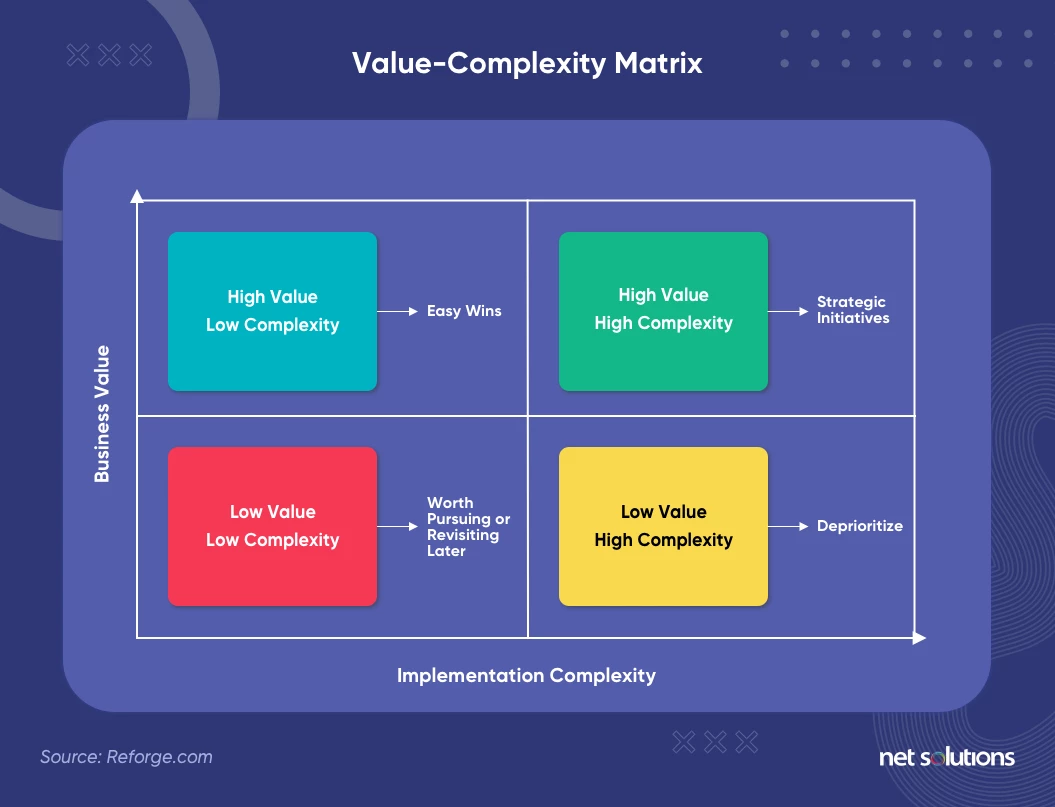
2. Weighted Scoring
Layer the value versus complexity quadrant approach with scoring to arrive at more concrete and objective results. Using this approach, you can productively decide which elements should go first and which should come later.
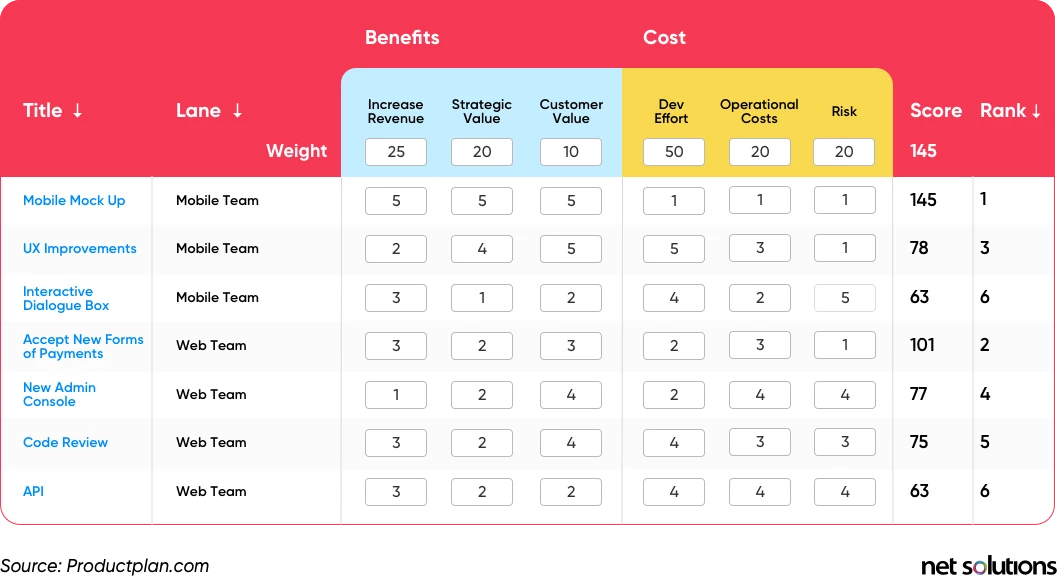
3. Kano Model
Prioritize elements based on how much satisfaction they will bring to your customers vs. how much effort you will have to put into bringing them to reality.
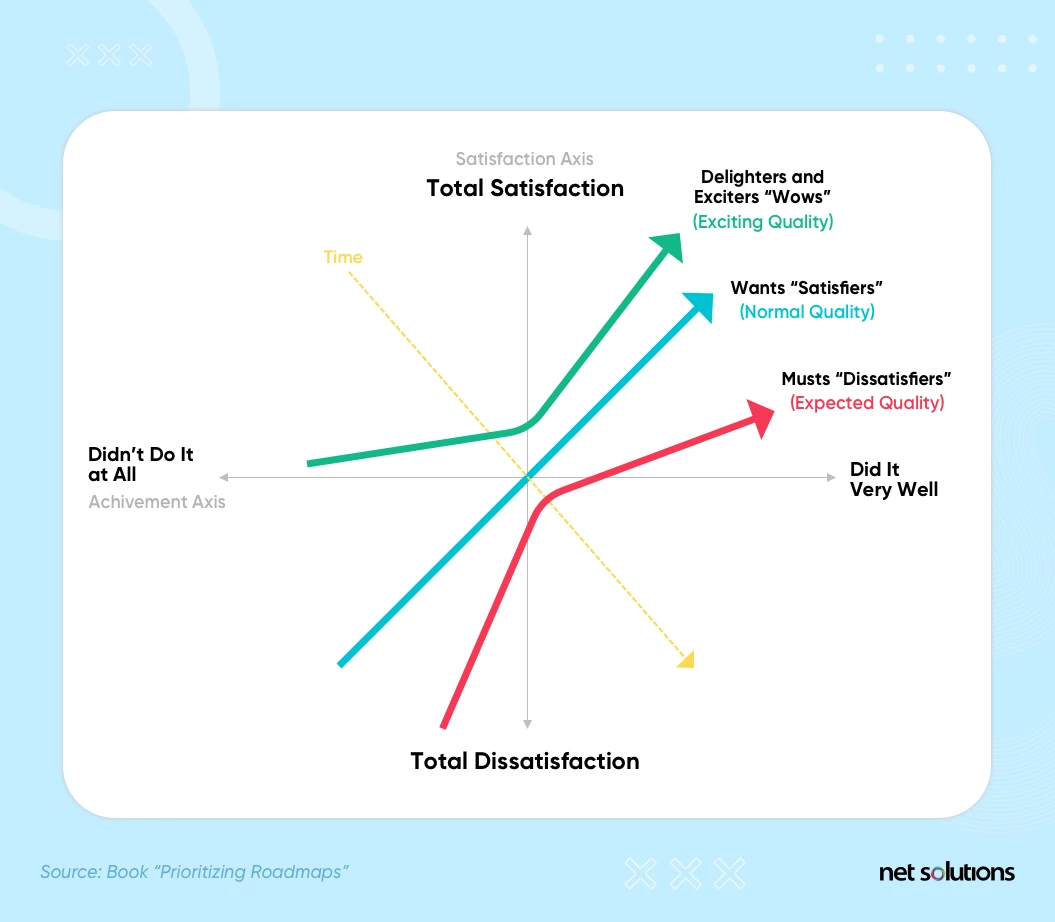
4. Opportunity Scoring
Use opportunity scoring to measure the importance of new elements based on customer satisfaction. The idea is to ask customers how important an element is to them and ask how satisfied they awith that element.
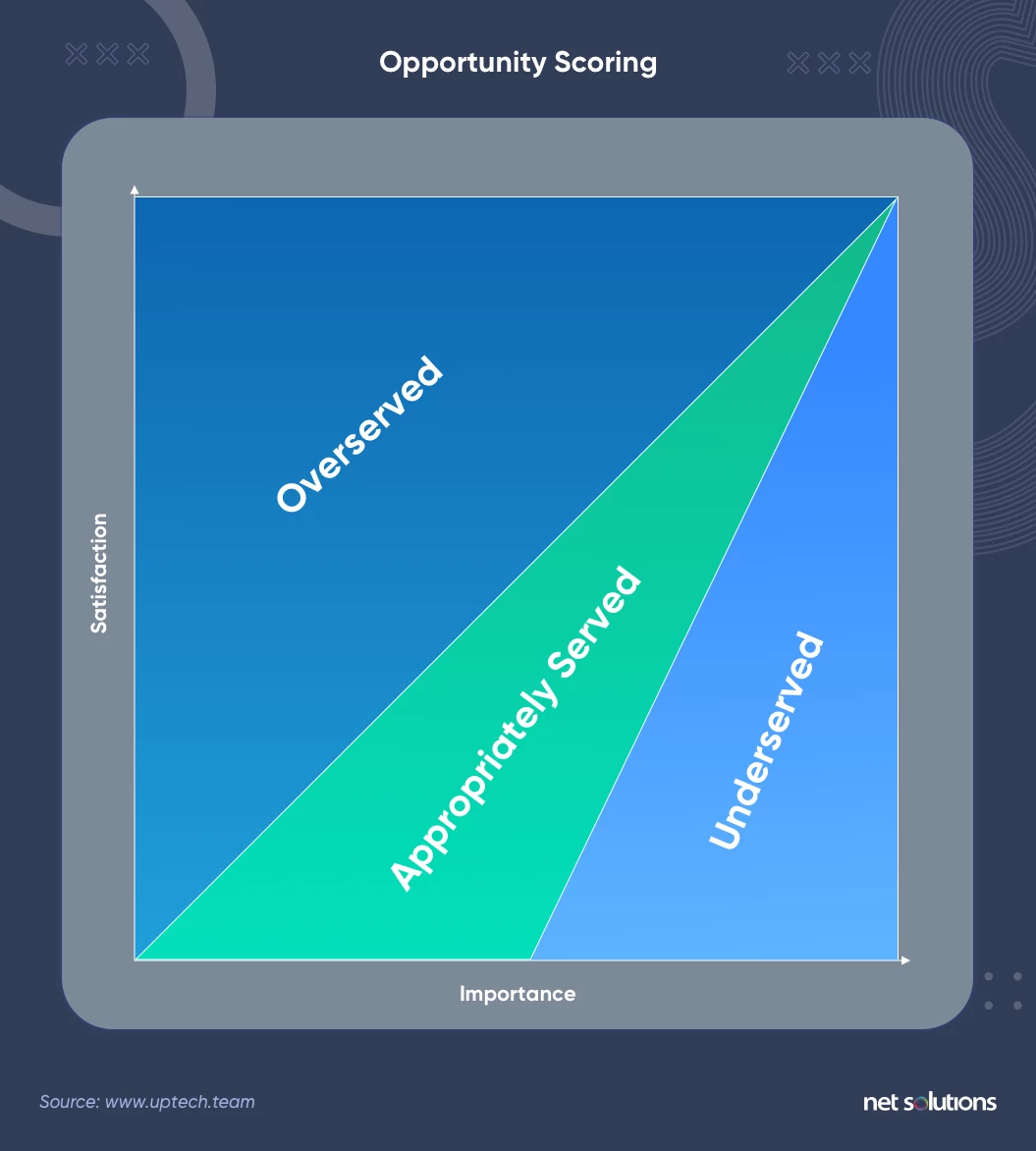
5. MOSCOW Prioritization
Prioritizing elements based on their importance. Here’s what MOSCOW means if you break it down:
- M: Must Have (Elements that are important and non-negotiable)
- S: Should Have (Elements that are important but secondary)
- C: Could Have (Non-essential and optional elements)
- W: Won’t Have (Elements that are not doable at this time but can be done in the future)
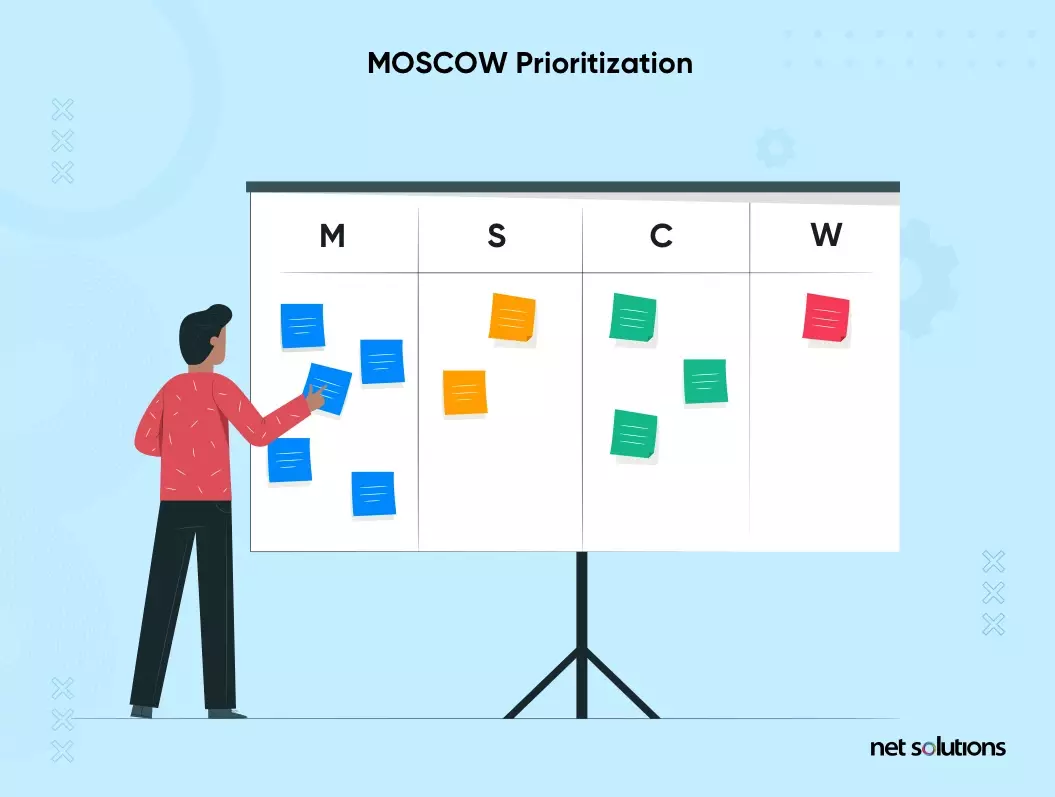
Step 4: Break Down Features Into User Stories
Product features can help you quickly understand your product. However, the problem is that they can’t easily fit into sprints. Hence, breaking down features into sprints is essential for further simplification.
Here are different ways to break down features into user stories:
- Break features into user stories by individual workflow steps. It will help you understand your product better and efficiently plan your work
- Categorize features by happy/unhappy flow, i.e., how functionality behaves when everything goes well vs. the scenario with exceptions, deviations, and other problems
- Break features by the data types they return or the parameters they should handle
- Break down features by operations like Create, Read, Update, or Delete
You can also break down stories by test cases, roles, platforms, acceptance criteria, usability requirements, and dependencies. In simple words, there are countless possibilities, and you can choose the ones you deem suitable.
A Few Things to Keep in Mind While Breaking Down Features into User Stories
- Keep tasks small, but not very small
- Each task should be precise in scope
- Use the user story’s acceptance criteria as a starting point and its definition of done as a checklist
- Know your and your team’s limits
Step 5: Share Your Product Roadmap with Stakeholders
Agile development is user-centric, prioritizing early and regular input from key stakeholders. Throughout the roadmapping process, prioritize regular buy-in from critical stakeholders to ensure the strategy is relevant and that user stories align with goals.
Common stakeholders who want to review the product roadmap are:
- Executives – High-level executives and management are interested in the overall product strategy, particularly market size or profitability data
- Marketing – Interested in product features, user stories, and how your product will differ from the market on a high level
- Sales – Interested in timelines, ‘go live’ dates and specific lists of benefits or differentiators
- Customer service – Your support team will need to be aware of, and trained, on the new products and all their features
- Agile team – The engineers, designers, developers, and testers need to buy into the idea and understand the details of the product backlog and user stories to design, develop, test, and provide feedback throughout the process. Their input is also crucial for planning your sprints
- Customers – Customers need to vet your ‘big idea’ as well as the resonance of your user stories – and are critical UX testers
The Agile product roadmap is a living document that needs to be viewed in various ways and levels of detail, depending on the audience.
Step 6: Measure Progress & Tweak the Product Roadmap
As this step suggests, the product roadmap needs to adapt and respond to changes in requirements and insights from the continuous testing and feedback of an Agile development approach. At the end of the product backlog and during Agile development sprints, it is essential to measure the work outcomes to keep track of the process or demonstrate that the goal has ultimately been met.
Bonus: A Few Product Roadmap Development Tips
Creating an effective product roadmap is not easy. Especially in an agile approach where requirements change frequently, you may face many challenges. But with the following product roadmap development tips, you can easily create an actionable, agile product roadmap:
- Always keep the end goal of your product in mind. Also, keep your end goal specific and measurable
- Each step should add up as if you are telling a coherent story about the growth of your product
- Avoid going too deep into your product roadmap, and keep it simple and easy to understand. Make sure you’re using no more than three to five features per goal
- Your product roadmap should be so interesting that all the stakeholders should buy into it. The best way to do this is to involve them in creating and updating the product roadmap.
- You want stakeholders to support your idea. But also dare to say “No” to suggestions that might not work in your product or don’t add to your goal.
- Keep reviewing and adjusting the product roadmap from time-to-time
Frequently Asked Questions
- Your existing & potential customers, prospects, and competition
- Your product strategy. It will give you a general direction
- Technologies you currently use. They may need an upgrade over time
- Your existing features. You may realize where they lack and how you can make them more robust
The product roadmap is typically the responsibility of the product manager or product owner. This person understands the customer’s needs and can decide on the product backlog and prioritize the user stories focusing on the goal and return on investment.
There are many product roadmap tools available in the market like Jira, ZohoSprints, ProductPlan, and Aha. You can use them to create highly-detailed and efficient product roadmaps.
Since the primary purpose of your roadmap is to communicate the big idea effectively, a roadmap should be straightforward. The roadmap’s format and level of detail will depend on the product, stakeholders, timeline, and team. As a living document, choose a format that appeals to key stakeholder groups, asking:
- What is the purpose of the roadmap?
- Who needs to view the roadmap?
- What information needs to be shown?
- Can the information be displayed visually?
- How do you express the timeframe?
- How do you communicate a product roadmap?
Communication of the roadmap will differ depending on the stage the organization is in, whether it’s getting that initial buy-in, developing the sprint cycles, or collecting feedback. In every step, it’s essential to create a culture of communication so that ideas and feedback continue to support the goal.
There is no single way a product roadmap can look. Although, here are some famous roadmap structures:
- GO product roadmap (goal-oriented product roadmap)
- Feature-based product roadmap
- Kanban roadmap
- A simple Trello board.

